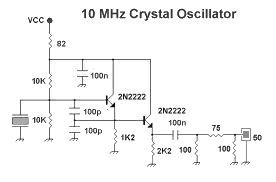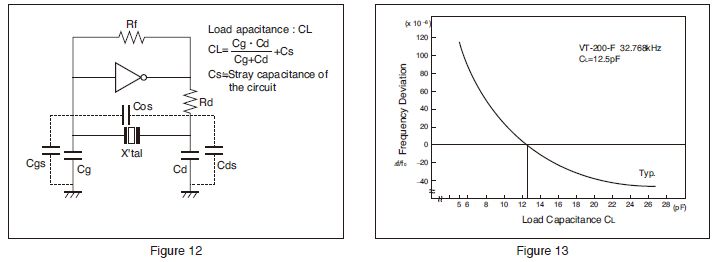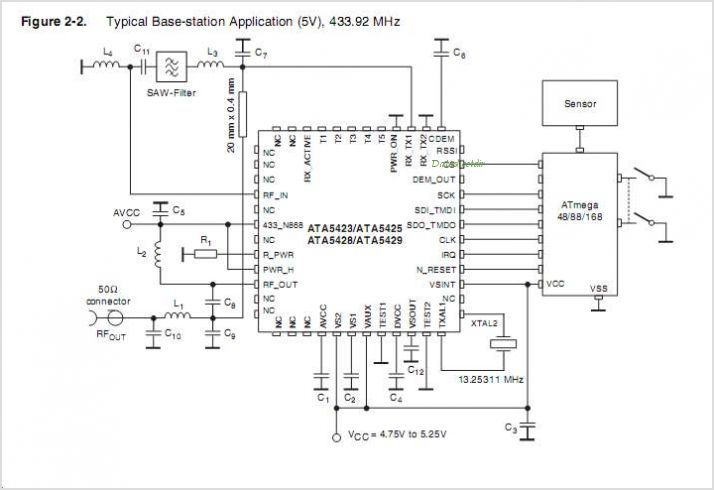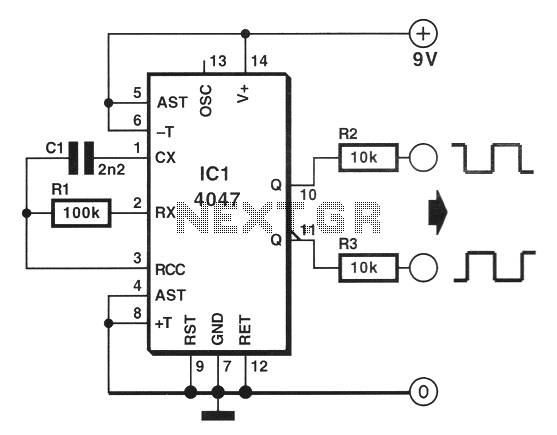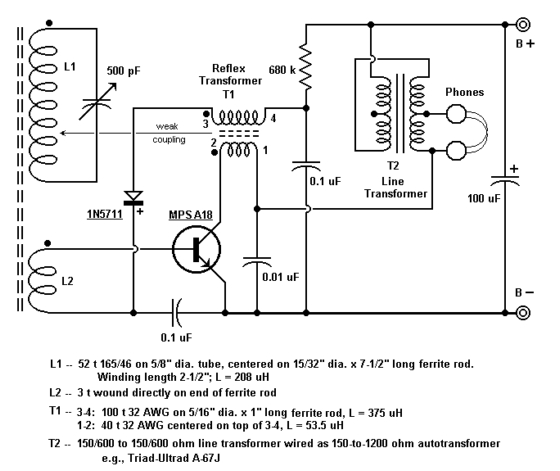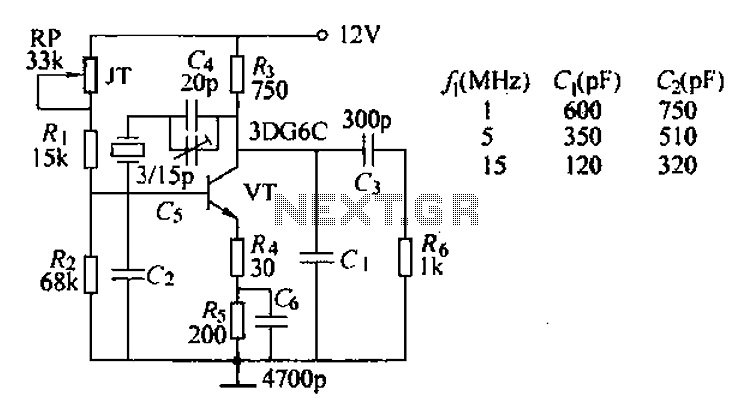
90-125 Mhz Crystal RF Oscillator
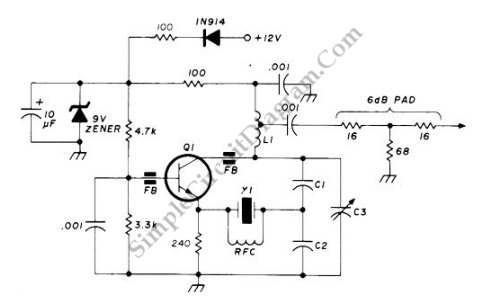
This circuit operates at a frequency range of 90-125 MHz and is particularly useful for VHF/UHF converters. It provides an output power of 5 to 15 mW. The circuit can utilize high-quality fifth- or seventh-over-tone crystal types. A ferrite bead (FB) prevents undesired oscillations from exceeding 500 MHz. To achieve optimal stability, a regulated power supply should be used, ensuring that the crystal operates at its natural series-resonant frequency. The schematic diagram includes the following components: C1 is a 10 pF mica capacitor, while C2 should have a high value, ranging from 20 to 60 pF, also mica. A 20 pF miniature trimmer or piston is designated as C3. The inductor L1 consists of 8 turns of 0.5 mm wire on an Amidon T37-12 toroid core, with 3 turns tapped from the cold end. For the transistor Q1, options include 2N5179, 2N2857, 2N3563, 2N918, or equivalent, with the Fairchild 2N5179 being the recommended choice. The RFC value is 0.39 H, resonating with the crystal holder capacitance. The maximum length of Y1 is 6 mm or 1/4 inch, with Y1 being a 90 to 125 MHz, 5th or 7th overtone, series-resonant HC-18/U crystal.
This circuit is designed to generate stable oscillations in the VHF/UHF frequency range, making it suitable for various applications in radio communications. The selection of components is critical for achieving the desired performance. The use of high-quality crystals ensures that the circuit maintains its frequency stability and minimizes phase noise, which is essential for reliable communication.
The mica capacitors, particularly C1 and C2, play a vital role in tuning the circuit. C1, with its 10 pF value, sets the base capacitance, while C2, with a higher value, allows for fine-tuning the resonant frequency. The inclusion of a trimmer capacitor (C3) provides additional flexibility in adjusting the circuit's frequency response, which is particularly useful for compensating for temperature variations or component tolerances.
The inductor L1 is carefully constructed with 8 turns of wire on a toroidal core, which helps in minimizing electromagnetic interference and improving the overall efficiency of the circuit. The tapping of 3 turns from the cold end allows for better coupling with the transistor, enhancing the gain and stability of the oscillator.
The choice of the transistor Q1 is also significant. The recommended Fairchild 2N5179 is known for its high-frequency performance and reliability. It is essential for amplifying the oscillations generated by the crystal, ensuring that the output power remains within the specified range of 5 to 15 mW.
Finally, the RFC (Radio Frequency Choke) value of 0.39 H is selected to resonate with the capacitance of the crystal holder, further stabilizing the oscillator circuit. The overall design emphasizes the importance of component selection and layout to achieve a robust and efficient oscillator circuit suitable for VHF/UHF applications.This is a circuit of 90-125 MHz Crystal which is very useful for VHF/UHF converters. This circuit provide 5 to 15 mW output. High-quality fifth- or seventh-over-tone crystal type can be used in this circuit. Undesired oscillation never reach above 500 MHz because of Ferrite bead FB. Using regulated power supply and allowing crystal to operate at i ts natural series-resonant frequency, will give best stability. Here is the schematic diagram of the circuit: The C1 is a 10pF mica. For C2, use as high value as possible such as 20 to 60pF mica. A 20 pF miniature trimmer or piston is used for C3. The value of L1 is 8 turns no 24(0. 5mm) on amidon T37-12 toroid core, tapped 3 turns fro cold end. For Q1, we can uses 2N5179, 2N2857, 2N3563m 2N918 or equivalent but fairchild 2N5179 is recommended. The value of The RFC is 0. 39 H which resonate with crystal holder capacitance. The maximum length of Y1 is 6mm or 1/4 ³. The value of Y1 is 90 to 125 MHz, 5th or 7th overtone, series-resonant, HC-18/U crystal. [Circuit`s schematic diagram source:J. Reisert, VHF/UHF Techniques, Ham Radio, March 1976, p 44-48] We aim to transmit more information by carrying articles. Please send us an E-mail to wanghuali@hqew. net within 15 days if we are involved in the problems of article content, copyright or other problems.
We will delete it soon. 🔗 External reference
This circuit is designed to generate stable oscillations in the VHF/UHF frequency range, making it suitable for various applications in radio communications. The selection of components is critical for achieving the desired performance. The use of high-quality crystals ensures that the circuit maintains its frequency stability and minimizes phase noise, which is essential for reliable communication.
The mica capacitors, particularly C1 and C2, play a vital role in tuning the circuit. C1, with its 10 pF value, sets the base capacitance, while C2, with a higher value, allows for fine-tuning the resonant frequency. The inclusion of a trimmer capacitor (C3) provides additional flexibility in adjusting the circuit's frequency response, which is particularly useful for compensating for temperature variations or component tolerances.
The inductor L1 is carefully constructed with 8 turns of wire on a toroidal core, which helps in minimizing electromagnetic interference and improving the overall efficiency of the circuit. The tapping of 3 turns from the cold end allows for better coupling with the transistor, enhancing the gain and stability of the oscillator.
The choice of the transistor Q1 is also significant. The recommended Fairchild 2N5179 is known for its high-frequency performance and reliability. It is essential for amplifying the oscillations generated by the crystal, ensuring that the output power remains within the specified range of 5 to 15 mW.
Finally, the RFC (Radio Frequency Choke) value of 0.39 H is selected to resonate with the capacitance of the crystal holder, further stabilizing the oscillator circuit. The overall design emphasizes the importance of component selection and layout to achieve a robust and efficient oscillator circuit suitable for VHF/UHF applications.This is a circuit of 90-125 MHz Crystal which is very useful for VHF/UHF converters. This circuit provide 5 to 15 mW output. High-quality fifth- or seventh-over-tone crystal type can be used in this circuit. Undesired oscillation never reach above 500 MHz because of Ferrite bead FB. Using regulated power supply and allowing crystal to operate at i ts natural series-resonant frequency, will give best stability. Here is the schematic diagram of the circuit: The C1 is a 10pF mica. For C2, use as high value as possible such as 20 to 60pF mica. A 20 pF miniature trimmer or piston is used for C3. The value of L1 is 8 turns no 24(0. 5mm) on amidon T37-12 toroid core, tapped 3 turns fro cold end. For Q1, we can uses 2N5179, 2N2857, 2N3563m 2N918 or equivalent but fairchild 2N5179 is recommended. The value of The RFC is 0. 39 H which resonate with crystal holder capacitance. The maximum length of Y1 is 6mm or 1/4 ³. The value of Y1 is 90 to 125 MHz, 5th or 7th overtone, series-resonant, HC-18/U crystal. [Circuit`s schematic diagram source:J. Reisert, VHF/UHF Techniques, Ham Radio, March 1976, p 44-48] We aim to transmit more information by carrying articles. Please send us an E-mail to wanghuali@hqew. net within 15 days if we are involved in the problems of article content, copyright or other problems.
We will delete it soon. 🔗 External reference
